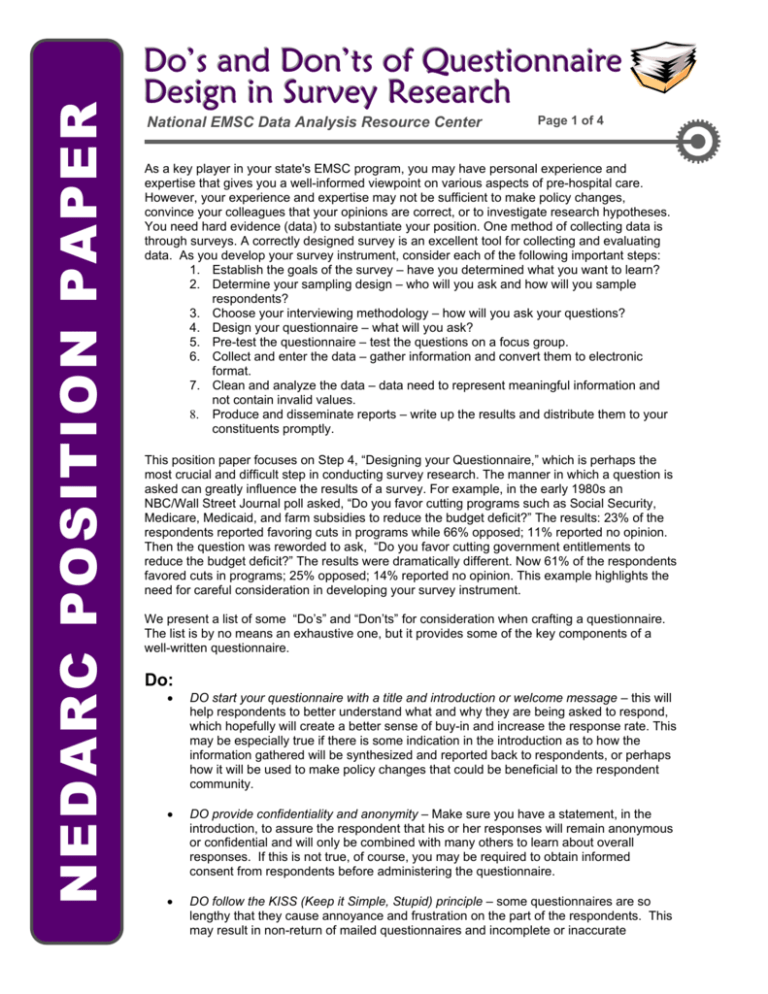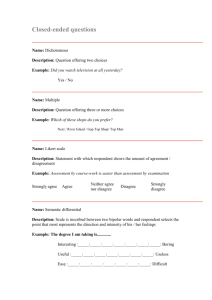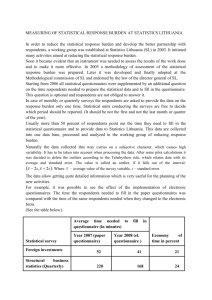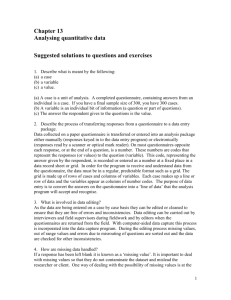Do's and Don'ts of Questionnaire Design in Survey
advertisement

NEDARC POSITION PAPER Do’s and Don’ts of Questionnaire Design in Survey Research National EMSC Data Analysis Resource Center Page 1 of 4 As a key player in your state's EMSC program, you may have personal experience and expertise that gives you a well-informed viewpoint on various aspects of pre-hospital care. However, your experience and expertise may not be sufficient to make policy changes, convince your colleagues that your opinions are correct, or to investigate research hypotheses. You need hard evidence (data) to substantiate your position. One method of collecting data is through surveys. A correctly designed survey is an excellent tool for collecting and evaluating data. As you develop your survey instrument, consider each of the following important steps: 1. Establish the goals of the survey – have you determined what you want to learn? 2. Determine your sampling design – who will you ask and how will you sample respondents? 3. Choose your interviewing methodology – how will you ask your questions? 4. Design your questionnaire – what will you ask? 5. Pre-test the questionnaire – test the questions on a focus group. 6. Collect and enter the data – gather information and convert them to electronic format. 7. Clean and analyze the data – data need to represent meaningful information and not contain invalid values. 8. Produce and disseminate reports – write up the results and distribute them to your constituents promptly. This position paper focuses on Step 4, “Designing your Questionnaire,” which is perhaps the most crucial and difficult step in conducting survey research. The manner in which a question is asked can greatly influence the results of a survey. For example, in the early 1980s an NBC/Wall Street Journal poll asked, “Do you favor cutting programs such as Social Security, Medicare, Medicaid, and farm subsidies to reduce the budget deficit?” The results: 23% of the respondents reported favoring cuts in programs while 66% opposed; 11% reported no opinion. Then the question was reworded to ask, “Do you favor cutting government entitlements to reduce the budget deficit?” The results were dramatically different. Now 61% of the respondents favored cuts in programs; 25% opposed; 14% reported no opinion. This example highlights the need for careful consideration in developing your survey instrument. We present a list of some “Do’s” and “Don’ts” for consideration when crafting a questionnaire. The list is by no means an exhaustive one, but it provides some of the key components of a well-written questionnaire. Do: • DO start your questionnaire with a title and introduction or welcome message – this will help respondents to better understand what and why they are being asked to respond, which hopefully will create a better sense of buy-in and increase the response rate. This may be especially true if there is some indication in the introduction as to how the information gathered will be synthesized and reported back to respondents, or perhaps how it will be used to make policy changes that could be beneficial to the respondent community. • DO provide confidentiality and anonymity – Make sure you have a statement, in the introduction, to assure the respondent that his or her responses will remain anonymous or confidential and will only be combined with many others to learn about overall responses. If this is not true, of course, you may be required to obtain informed consent from respondents before administering the questionnaire. • DO follow the KISS (Keep it Simple, Stupid) principle – some questionnaires are so lengthy that they cause annoyance and frustration on the part of the respondents. This may result in non-return of mailed questionnaires and incomplete or inaccurate NEDARC POSITION PAPER National EMSC Data Analysis Resource Center Page 2 of 4 responses on questionnaires administered in-person or by phone. To avoid this problem the investigator should carefully define the information required and write as few questions as possible to obtain that specific information. Questions that are peripheral, unimportant, and unnecessary to the study goal should not be included. • DO write questions and responses with clear objectives, concise language, complete sentences, correct grammar, and simple words – Although one goal of questionnaire design is conciseness, this should not be done at the cost of posing confusing questions in incomplete sentences filled with arcane abbreviations. Few people may have difficulty with “Your Name” or “Your Title” questions, but many may have difficulties answering “Years in this community.” Does this refer to years or months, lived or worked, or respondent or family in this community? • DO be specific in asking each question – By just asking, “What is your income?” for example, respondents may not know what is meant by income. Income may refer to yearly/monthly salary, hourly wages, income from more than one job, or total household income. The other problem with not being specific in asking the income question is that it is unknown if the investigator is interested in knowing about respondents’ last year income, last month income, or income for a certain period of time. • DO place personal and confidential questions at the end of the questionnaire – The early appearance of disconcerting questions may result in respondents discontinuing the questionnaire resulting in a lower overall response rate. • DO require responders to carefully read each question by varying the way the questions are asked – Problems may arise when responders are asked to rate items for which the general level of approval is high. There is a tendency for responders to mark every item at the same end of the scale. This is called habituation and refers to a problem that applies to a series of questions that all have the same answer choices. One effective way to reduce habituation is to vary the way in which the questions in a series are asked. This technique forces the respondent to think and evaluate each response choice rather than uniformly agreeing or disagreeing to all of the responses, but it must be done carefully so that respondents clearly understand the questions being asked. • DO design responses that are mutually exclusive – It simply means that response categories should not overlap if you are interested in obtaining a discrete response to a particular question. Valuable information may be lost as a result of not providing mutually exclusive response categories. See page 4 for an example of mutually exclusive categories. • DO allow “don’t know” and “not applicable” responses where appropriate – Sometimes “don't know” or “not applicable” will really represent some respondents' most honest answers to some of your questions. Respondents who feel they are being coerced into giving an answer they do not want to give often do not complete the questionnaire. For example, many people will abandon a questionnaire that asks them to specify their income, without offering a "decline to state" choice. • DO test your questionnaire – Be sure you pilot or pre-test it on individuals representative of your target audience (Step 5). This will help identify weaknesses and potential difficulties in the wording and design of the instrument from their point of view. While the questionnaire designers may review and test the instrument among themselves, this group is not representative of users, and the designers often miss serious problems with their own survey instrument. Don’t: • DON’T be vague – Try to avoid using vague quantifiers such as “regularly,” “often,” “rarely,” etc. These quantifiers don’t convey the same meaning for all respondents. NEDARC POSIITION PAPER National EMSC Data Analysis Resource Center Page 3 of 4 Depending on the question asked, a respondent may interpret “regularly” as once or twice a week, while it means five to six times a week to another respondent. • DON’T ask double-negative questions – Respondents can easily be confused deciphering the meaning of a question that uses two negative words. For example, "Should the police chief not be directly responsible to the mayor?" The question is ambiguous; almost any answer will be even more so. • DON’T use many abbreviations, acronyms, or jargon – By using technical terms, abbreviations, acronyms, or jargon in your survey you run the risk of lower response rates if respondents are not familiar with those terms and acronyms. Therefore, avoid using them unless you are absolutely sure that respondents know what they mean. • DON’T ask objectionable or value-laden questions – When a question contains a valueladen term, respondents may answer emotionally, without regard for the context in which the term is used. If you ask people's attitudes toward a specific government social program and characterize it as "liberal" or "conservative," people are likely to react to their feelings about "liberal" or "conservative" and not about the program itself. • DON’T ask leading questions – A leading question suggests an answer. Consider this example: “In order to improve the quality of EMS, should EMS providers be paid higher salaries?” This question presents a widely accepted goal (improving the quality of EMS) accompanied by the assumption that the means suggested (raising EMS provider salaries) will accomplish the goal – and thus will influence the respondent to answer "yes." DON’T ask open-ended questions unless necessary – It is tempting to ask open-ended questions; that is, instead of including a list of responses from which respondents have to choose, the respondent is asked to explain his or her position. However, you should try not to include many such questions, but try to limit yourself to one or two. Including too many such questions will seriously change your response rate. Answering openended questions requires more time and thought than selecting answers from a preexisting list of alternatives. With many open-ended questions, more people will decide that it is too much trouble to complete the survey. The responses to open ended questions are also more difficult to analyze. • • DON’T ask “double-barreled questions” – A double-barreled question contains two or more distinct questions but allows only one answer resulting in either a non-response or a response that is hard to interpret. See page 4 for an example. • DON’T ask hypothetical questions – People usually have problems in answering questions that relate to circumstances they have not experienced. For example, asking people how they would feel about certain topics if they were living in a different culture with different values and norms is difficult to answer. • DON’T ask respondents to make unnecessary calculations – When respondents are asked to report percentages, some may actually perform precise calculations while others just guess. Simple counts and numeric answers may be more easily available to respondents and will avoid arithmetic errors. NEDARC POSIITION PAPER National EMSC Data Analysis Resource Center Page 4 of 4 Table 1: Question Examples, Associated Problems, and Possible Improvements Naive Wording Problem with Wording This is an example of not being specific and also not stating the question in sentence format This is an example of not asking mutually exclusive responses Possible Improvement What was your age (in years) at your last birthday? Age response categories: 34 or less, 35-49, 50-64, 65 and over How many times have you been an inpatient in the past year? This is an example of being vague. What does a year mean – 12 months ago from now, since Jan 1, etc. Also what does it mean to be an “inpatient?” Do you believe that outdated pre-hospital care providers have kept pace with the incredible advances in medicine? This is an example of asking objectionable or value-laden question. Which of the following performance measures are not used in your prehospital care service? In the past month, have you ever tried to reduce the rate of unintentional injuries by conducting injury prevention workshops? This is an example of asking a negative question. From a scale of 1 to 5, please state how satisfied you are with our BLS and ALS service? This is another example of asking a double-barreled question and also using acronyms. (The obvious problem is some respondents may be satisfied with one service or the other but not both. Also, some people may not know what BLS and ALS stand for.) In the past twelve months, how many different times have you been admitted to a hospital as a patient overnight or longer? From a scale of 1 to 10, how do you compare advances made in prehospital care practices with advances made in general medicine? Which of the following performance measures are used in your prehospital care service? a. In the past month, have you conducted an injury prevention workshop? b. Was the purpose of the workshop to reduce the rate of unintentional injuries? Break this question into two questions, one for BLS and one for ALS, and spell out BLS and ALS. Age Age response categories: 35 or less, 35-50, 50-65, 65 and over This is an example of asking a double-barreled question. A survey questionnaire is a frequently used tool to collect data in various fields including EMS. There has been an extensive amount of research focused on survey design, but this position paper simply describes some of the key “do’s” and “don’ts” of designing a questionnaire. Other steps listed at the beginning of this paper equally contribute to the development of a welldesigned survey study. It is important to remember that the process of conducting a survey starts by having a clear idea of what you want to study, a process by which you formulate your theory and hypotheses, as well as your plans for analyzing the results. Proper attention to survey design will improve the quality of your project and provide you with the reliable information you need. If you have any questions about the information in this document or would like to learn more, please contact the National EMSC Data EMSC Resource Center through www.nedarc.org or by calling (801) 5816410.









